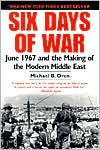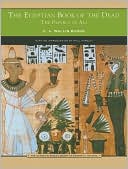Six Days of War: June 1967 and the Making of the Modern Middle East
Though it lasted for only six tense days in June, the 1967 Arab-Israeli war never really ended. Every crisis that has ripped through this region in the ensuing decades, from the Yom Kippur War of 1973 to the ongoing intifada, is a direct consequence of those six days of fighting. Michael B. Oren’s magnificent Six Days of War, an internationally acclaimed bestseller, is the first comprehensive account of this epoch-making event.\ Writing with a novelist’s command of narrative and a historian’s...
Search in google:
In Israel and the West it is called the Six Day War. In the Arab world, it is known as the June War, or simply as "the Setback." Never has a conflict so short, unforeseen and largely unwanted by both sides so transformed the world. The Yom Kippur War, the war in Lebanon, the Camp David accords, the controversy over Jerusalem and Jewish settlements in West Bank, the intifada and the rise of Palestinian terror: all are part of the outcome of those six days of intense Arab-Israeli fighting in the summer of 1967. Michael B. Oren's Six Days of War is the most comprehensive history ever published of this dramatic and pivotal event, the first to explore it both as a military struggle and as a critical episode in the global Cold War. Oren spotlights all the participants—Arab, Israeli, Soviet, and American—telling the story of how the war broke out and of the shocking ways it unfolded. Drawing on thousands of top-secret documents, on rare papers in Russian and Arabic, and on exclusive personal interviews, Six Days of War recreates the regional and international context which, by the late 1960s, virtually assured an Arab-Israeli conflagration. Also examined are the domestic crises in each of the battling states, and the extraordinary personalities—Moshe Dayan and Gamal Abdul Nasser, Hafez al-Assad and Yitzhak Rabin, Lyndon Johnson and Alexei Kosygin—that precipitated this earthshaking clash. Publishers Weekly This is the most complete history to date of the Six Day War of 1967, in which Israel entered and began its occupation of the West Bank and Gaza Strip. While no account can be definitive until Arab archives open, Oren, a Princeton-trained senior fellow at Jerusalem's Shalem Center who has served as director of Israel's department of inter-religious affairs and as an adviser to Israel's U.N. delegation, utilizes newly available archival sources and a spectrum of interviews with participants, including many Arabs, to fill gaps and correct misconceptions. Further, Six Days of War is an attack on "post-Zionism": the school of politics and history that casts Israel as the author of policies that intentionally promote the destuction of Palestine as a separate entity and of Palestinians as a people, not least through the occupation that began with the 1967 War. By contrast, Oren convincingly establishes in an often engrossing narrative the reactive, contingent nature of Israeli policy during both the crisis preceding the conflict and the war itself. As Prime Minister Levi Eshkol held the Israeli Defense Forces in check that May, Operation Dawn, an Egyptian plan for a preemptive strike against Israel, came within hours of implementation. It was canceled only because Egypt's President Gamal Abdel Nasser feared it had been compromised. Israel's decision to seek its own security in arms was finally triggered, Oren shows, by Jordan's late accession to the hostile coalition dominated by Egypt and Syria. Geographically, the West Bank, then under Jordanian rule and occupation, cut Israel nearly in half. The military risk to Israel was unacceptable, Oren makes clear, in the context of a U.S. enmeshed in Vietnam and a West unwilling to act even in support of the status quo. Far from being a product of strategic calculation, Oren further argues, occupation of the West Bank and the Gaza Strip was also contingent: the consequence of a victory so rapid and one-sided that even Israel's generals found it difficult to believe it was happening. Israel, having proved it could not be defeated militarily and now possessing something to trade, hoped for comprehensive peace negotiations in a rational-actor model. Oren notes that some initiatives for peace did in fact develop. He seems, however, trying to convince himself along with his readers. Oren puts what he sees as Israel's enduring weaknesses in relief: not arrogance, but self-doubt, self-analysis and self-criticism, all carried to near-suicidal degrees in 1967. Arab policy, by contrast, featured a confident commitment to erasing Israel from the map. The Six Day War shook that confidence, he finds, but did not alter the commitment. About the nature of Israeli policy since the war, the book says little, but finds that "for all its military conquests, Israel was still incapable of imposing the peace it craved." Copyright 2002 Cahners Business Information.
Afterwood\ MORE THAN TWO YEARS HAVE PASSED since the outbreak of the latest Middle Eastern turmoil, and there is still no cease-fire in sight. Called by Palestinians the al-Aqsa Intifada, and by the Israelis the “disturbances,” the “events,” or, simply, the Palestinian terror, the violence that erupted in September 2000, and which has raged ever since, is in every sense a war. No less than in 1948 and 1967, Arabs and Israelis are today once again battling over the final disposition of the area known in Arabic as Filastin and in Hebrew as Eretz Yisrael—the Land of Israel. As in the processes leading up to previous Arab-Israeli confrontations, mounting violence between Palestinians and Israelis threatens to set the entire region ablaze.\ In many respects, the current fighting resembles the civil war in Palestine that broke out in November 1947, following the UN’s decision to partition the country into independent Jewish and Arab states. The Zionist leadership accepted the notion of territorial compromise, but the Arabs of Palestine saw no reason to forfeit what they considered their exclusive national rights, and determined to block the partition with attacks against Jewish settlements, road systems, and neighborhoods. Other Arab forces, most prominently those associated with the militant Muslim Brotherhood, aided the Palestinian Arabs from across the border. The Jews, for their part, initially showed restraint, but in April 1948, fearing annihilation, they too went to war. Subsequently, dozens of Arab villages and towns were destroyed, their populations displaced, and their leaders either killed or rendered ineffective. But the Palestinians’ defeat generated sympathy throughout the Arab world and intensified the pressure on Arab leaders to intervene against the Jews. The result came one month later with the advent of the first Arab-Israeli war.\ A remarkably similar process occurred more than fifty years later, in the latter half of 2000, when the Clinton Administration again proposed to partition the land between the Palestinians and the Jews. Specifically, the United States called for the creation of a Palestinian state in virtually all of the West Bank and the entire Gaza Strip—Israeli settlements would either be removed or concentrated in blocks—with its capital in East Jerusalem. A small number of Palestinian refugees would be repatriated to Israel; the rest were to receive compensation. The Palestinian state would live side by side with Israel in relations of full peace, but while Israeli prime minister Ehud Barak approved the formula, the Palestinian Authority under its president, Yasser Arafat, rejected it. Rather, Arafat demanded the return of all the refugees—a move that, if implemented,\ would have created a Palestinian majority in Israel. As in 1947–48, the issue was not merely the borders of the Jewish state, but its very existence.\ The Palestinians consequently embarked on an armed offensive using tactics reminiscent of those employed in 1947–48—roadside ambushes, snipers,\ and car bombs—together with the innovation of suicide bombers. Militant Islamic elements once more played a prominent role in the campaign. At first,\ Israel’s reaction was again restrained, but as casualties rapidly mounted, the IDF finally struck back. In April 2002, Israeli forces reoccupied much of the West Bank, causing extensive damage to Palestinian cities and villages, and killing or isolating many Palestinian leaders. As in 1948, the Palestinians’ plight aroused sympathy in neighboring Arab countries and placed pressure on their leaders to intercede. Soon Hezbollah guerrillas in Lebanon were launching rockets into northern Israel; the Syrian army went on high alert, as did units in Jordan, Egypt, and Iraq. Israel mobilized its reserves. The region careered toward yet another Arab-Israeli war.\ The fighting in 2000–2002 recalled not only the events of 1947–48 but,\ even more poignantly, those of 1967. That war, this book asserts, was the result of a series of incidents triggered by Palestinian guerrilla raids and Israel’s retaliations against them. Today, more than three decades later, the Middle East is still in the grips of a context of conflict in which a single spark can ignite a regional conflagration. Such a spark was kindled in September 2000, when Ariel Sharon, then head of Israel’s parliamentary opposition, paid a visit to the Haram al-Sharif, or Temple Mount, in Jerusalem.\ Though the visit had been cleared with the Palestinian Authority, many Palestinians viewed it as a provocation and protested against it violently. Firing on the rioters, Israeli forces provided the pretext for launching an intifada, or popular uprising, named after the Haram’s al-Aqsa mosque. Mass demonstrations of Palestinian youths soon escalated into armed attacks against Israeli targets, most of them civilian, and increasingly fierce countermeasures by Israel.\ Israeli reprisals in turn instigated unrest in adjacent Arab countries. The\ “street” was once again agitating—a déjà vu of 1967—and Arab rulers had little choice but to act.\ Unlike in 1948 and 1967, however, war between Arabs and Israelis did not erupt in 2002. Though the region has remained in many ways unchanged, several fundamental transformations nevertheless have combined to mitigate the dangers of war.\ There is, firstly, the existence of peace treaties between Israel and Egypt and Israel and Jordan. In spite of their failure to bring about any true reconciliation between their signatories, these agreements have nonetheless provided the nations with open channels of communication and venues for reducing tensions.\ Another change is the emergence of the U.S.-Israeli alliance that not only guarantees Israel a decisive military edge over its enemies, but also affords Washington far-reaching influence over Israeli actions. Finally, there is the nonconventional weaponry now in the arsenals of virtually every Middle Eastern state, which has sharply elevated the stakes in any Arab-Israeli confrontation.\ Yet for every change curtailing the chances of war, another could equally contribute to its outbreak. Absent today is the peculiar stability engendered by the Cold War, of a rational counterpart whom the U.S. president might hotline in a crisis, and superpower constraints over key regional players such as Iraq,\ Iran, and Syria. The once neat division between Arab radicals and Arab conservatives has been replaced by internal fissures within each Arab country—between each regime and its domestic, often Islamic, opposition—and even the lines in the Arab-Israeli conflict have become obscured. Most destabilizing,\ arguably, is the growth of terrorist organizations, global in outlook and adamant in their theology, transcending all borders and contemptuous of any attempt to restrain them.\ These countervailing changes, coupled with the continuing friction surrounding nondemocratic Middle Eastern regimes and Arab resistance to the very idea of a Jewish state, might have set the stage for an Arab-Israeli war bigger and possibly more destructive than those of 1948 and 1967. Instead, war in 2002 was averted by the timely intervention of the United States. As tensions in the region spiraled toward an explosion, President George W. Bush strongly advised Syria to rein in its Hezbollah allies and told the Palestinian Authority that its support of terror was totally unacceptable to Americans. At the same time, Washington publicly recognized Israel’s right to defend itself and convinced Israelis that they did not stand alone. Bush’s actions—admonishing the Arabs and reassuring the Israelis—were precisely those that Lyndon B. Johnson failed to take in 1967, and in 2002 they succeeded in containing, if not defusing, the crisis.\ Like Johnson, Bush was engaged in an international struggle with an implacable enemy—no longer communism, of course, but Islamic extremism—\ but rather than tie his hands as Vietnam once had Johnson’s, America’s new conflict impelled George Bush to act. The events of September 11, 2001, spurred a radical departure from long-standing American policies toward the Middle East.\ Having become the victim of large-scale Arab terror, the administration voiced newfound empathy for Israel and its struggle against suicide bombers and gunmen,\ and went so far as to identify Israel’s enemies—Hamas and Islamic Jihad—\ as America’s. Moreover, in declaring war against international terrorism, in dispatching its soldiers thousands of miles to fight in Afghanistan and, avowedly,\ in Iraq, Washington could hardly deny Israel the ability to strike back in the West Bank and Gaza, its own backyard. Concomitantly, American leaders expressed severe reservations regarding the Arab states, even toward their traditional allies, Egypt and Saudi Arabia, citizens of which were heavily implicated in 9/11. Relations between the U.S. and the Arab world were further strained by the Arabs’ reluctance to support a military effort to invade Iraq and oust its dictator, Saddam Hussein.\ The success of Bush’s effort to rally an anti-Saddam coalition is not, as of this writing, guaranteed. Numerous obstacles, domestic and foreign, stand in the president’s way. Nor is it certain whether the toppling of Saddam will install democracy or merely another dictatorship in Iraq, or whether war in the gulf will ultimately enhance or further impair the area’s stability. One fact,\ alone, is incontestable: that the Middle East remains a flash point of multilateral confrontation, a source of seemingly intractable controversies, and a powder keg that the slightest spark could ignite. A context of conflict continues to seize the region, demanding of its leaders almost constant displays of both courage and caution.\ November 2002
List of MapsAcknowledgmentsA Note on Sources and SpellingsForewordThe Context: Arabs, Israelis, and the Great Powers, 1948 to 19661The Catalysts: Samu' to Sinai33The Crisis: Two Weeks in May61Countdown: May 31 to June 4127The War: Day One, June 5170Day Two, June 6211Day Three, June 7240Day Four, June 8257Day Five, June 9278Day Six, June 10294Aftershocks: Tallies, Postmortems, and the Old/New Middle East305Afterword328A Conversation with Michael B. Oren332Notes342Bibliography and Sources416Index434
\ From Barnes & NobleAs the Middle East reels from wave after wave of terrorist attacks and seemingly endless reprisals, Michael B. Oren, an acknowledged expert on that troubled region, takes us back to the events of "Six-Day War" of June 1967 and shows how what transpired then deeply affects what is happening there now.\ \ \ \ \ Publishers WeeklyThis is the most complete history to date of the Six Day War of 1967, in which Israel entered and began its occupation of the West Bank and Gaza Strip. While no account can be definitive until Arab archives open, Oren, a Princeton-trained senior fellow at Jerusalem's Shalem Center who has served as director of Israel's department of inter-religious affairs and as an adviser to Israel's U.N. delegation, utilizes newly available archival sources and a spectrum of interviews with participants, including many Arabs, to fill gaps and correct misconceptions. Further, Six Days of War is an attack on "post-Zionism": the school of politics and history that casts Israel as the author of policies that intentionally promote the destuction of Palestine as a separate entity and of Palestinians as a people, not least through the occupation that began with the 1967 War. By contrast, Oren convincingly establishes in an often engrossing narrative the reactive, contingent nature of Israeli policy during both the crisis preceding the conflict and the war itself. As Prime Minister Levi Eshkol held the Israeli Defense Forces in check that May, Operation Dawn, an Egyptian plan for a preemptive strike against Israel, came within hours of implementation. It was canceled only because Egypt's President Gamal Abdel Nasser feared it had been compromised. Israel's decision to seek its own security in arms was finally triggered, Oren shows, by Jordan's late accession to the hostile coalition dominated by Egypt and Syria. Geographically, the West Bank, then under Jordanian rule and occupation, cut Israel nearly in half. The military risk to Israel was unacceptable, Oren makes clear, in the context of a U.S. enmeshed in Vietnam and a West unwilling to act even in support of the status quo. Far from being a product of strategic calculation, Oren further argues, occupation of the West Bank and the Gaza Strip was also contingent: the consequence of a victory so rapid and one-sided that even Israel's generals found it difficult to believe it was happening. Israel, having proved it could not be defeated militarily and now possessing something to trade, hoped for comprehensive peace negotiations in a rational-actor model. Oren notes that some initiatives for peace did in fact develop. He seems, however, trying to convince himself along with his readers. Oren puts what he sees as Israel's enduring weaknesses in relief: not arrogance, but self-doubt, self-analysis and self-criticism, all carried to near-suicidal degrees in 1967. Arab policy, by contrast, featured a confident commitment to erasing Israel from the map. The Six Day War shook that confidence, he finds, but did not alter the commitment. About the nature of Israeli policy since the war, the book says little, but finds that "for all its military conquests, Israel was still incapable of imposing the peace it craved." Copyright 2002 Cahners Business Information.\ \ \ Library JournalIn perhaps one of the most valuable recent works on this subject, Oren, a scholar and Senior Fellow at the Shalem Center, Jerusalem, details events from the Six Day War known in the Arab world as Al-Naksah (the setback) or simply the June war. The book's value lies in its focus and extensive documentation of multilingual resources, including archives, newspapers, reports, books, interviews, and Internet sites. In addition, Oren covers the international, regional, and domestic implications of the war and uses maps to illustrate the geographical changes and military strategies. Many books, e.g., Ahron Bregman's Israel's War: 1947-1993, Tibi Bassam's Conflict and War in the Middle East, 1967-91, and Eric Hammel's Six Days in June, cover a broader period, rely heavily on analysis, or fall short of objectivity. While Oren also recounts some necessary historical context for understanding the war's catalysts and discussing its aftermath, he primarily focuses on the pivotal six days of conflict, dedicating a full chapter for each day. Predictably, the most controversial information is his new findings on an Egyptian top-secret plan that came very close to eradicating Israel's army and nuclear power plant. While this is an essential addition for academic libraries, the book's exhaustive documentary style makes it a lesser candidate for public libraries. Ethan Pullman, Univ. of Pittsburgh Lib. Copyright 2002 Cahners Business Information.\ \ \ \ \ Kirkus ReviewsA thoroughgoing analysis of the events that combusted 35 years ago to produce a maelstrom in the Middle East. Readers comparing historian Oren's thesis to current headlines may feel a certain sense of deja vu. He traces the origins of the Six-Day War of 1967 to several causes that were in no way resolved by the conflict, and underlines one of its effects-the Israeli conquest of the Sinai peninsula and the West Bank-that remains a subject of controversy today. One of those causes was resurgent nationalism in the Arab world's "postcolonial, revolutionary period," when Egyptian president Nasser attempted to play the Soviet Union off against the US, and to craft a military and political union of Syria, Jordan, Iraq, and Egypt; Nasser's United Arab Republic soon collapsed, but among the unintended consequences of the destabilization were the rise of the Assad regime in Syria and, eventually, Saddam Hussein's regime in Iraq. Another was a sudden upsurge of Palestinian nationalist activity, leading to the formation of groups such as al-Fatah and the PLO. Still another was internal conflict in Israel over whether and how to accommodate the demands of its neighbors. Slowly taking shape throughout the early and mid-1960s, these conditions "created an atmosphere of extreme flammability," Oren writes. "In such an atmosphere, it would not take much-a terrorist attack, a reprisal raid-to unleash a process of unbridled escalation, a chain reaction of dare and counterdare, gamble and miscalculation, all leading inexorably to war." Of course, that is exactly what happened, and Oren's narrative traces the military course of the war and its political aftermath, including lingering tensions in US-Israeli relations following the (accidental, in Oren's view) Israeli attack on the US naval vessel Liberty. Careful and well documented: Oren (Senior Fellow/Shalem Center, Jerusalem) finds fault on all sides of the conflict, which is sure to earn him critics everywhere he turns. Essential reading for anyone seeking to understand the history of the troubled region.\ \








